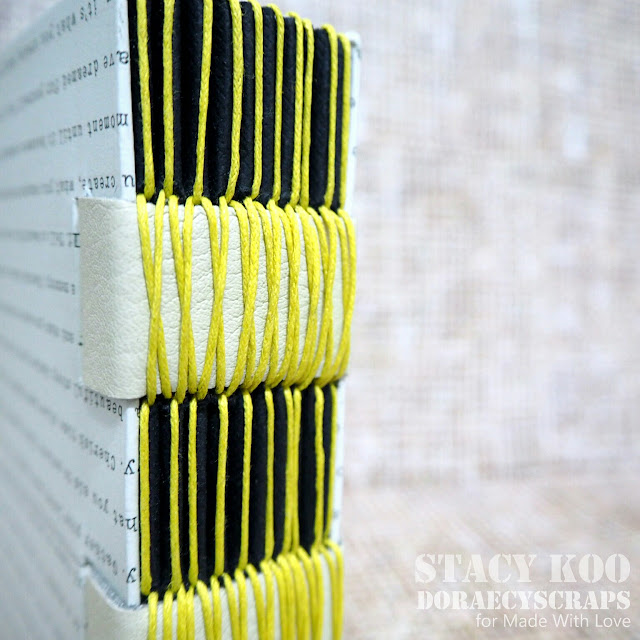Hello fellow crafters! I am back today with a project for Made With Love! This time, I am inspired by long stitch binding to come up with not only 1 but multiple designed long stitch books!
3. Variety of patterns
The long stitch structure had its heyday in the middle ages when it was popular across the Europe. Typical materials were leather, vellum and cartonnage.
There are many reasons why I am keen to make use of long stitch binding in my frequently used books, and here are some of them:
1. Cover Materials
The long stitch sewing can be combined with various other structures, whether it is exposed spine, hard cover binding, or soft cover binding. This allows me to work with different kind of materials and explore more into the different "feel" when it comes to cover making.
Not only can it be used as a notebook stitch, it can also be used for making mini albums and scrapbooks. There is also an added possibility of different types of cover. Sometimes, I add a flap to the cover so it locks the notebook in place. I could also leave it to expose the sides of the signature.
 |
| Long Stitch Binding, otherwise also known as Lattice Binding |
 |
| Long Stitch Binding, otherwise also known as double star binding |
The stitching along the spine is visually appealing and can be altered to form patterns and weaves. Another long stitch technique is done in conjunction with chain stitch. The possibilities are never ending - it's up to your own exploration and imagination!
 |
| Weaving and Alternate Long Stitch |
 |
| Long Stitch with chain stitch |
4. No glue, no fuss
The text block is sewn directly through the cover material which eliminates the need of linings, tapes, hinges, sanding and adhesives common in other types of bindings. Often long stitch bindings are completely glue-free. I like that there is no fuss that goes around this stitching method.
5. Variation of binding strings
Long stitch allows you to explore the use of different strings for the binding, be it waxed thread, twine or even leather threads. Different sewing threads can give a different outlook to the entire project.
 |
| Twine |
 |
| DMC Thread |
That is why I explore much into this simple yet complicated stitching. There are so many ways to elaborate on the long stitch binding and it is bound to give a different feel with different binding techniques, materials, and colors.
~Some Tools I Use~
If you are keen to get started on book binding, you will need some simple tools to help you along this wonderful journey. Personally, these are the tools which I typically use on a daily basis:
1. Penknife / Craft Knife
Having a sharp blade is very helpful when you want that perfect edge for the signatures. While the book publishers have machines to cut the straight edges, we book binders depend on the craft knife to accomplish the same purpose.
2. Piercer
This tool is another important tool for book binding. It allows us to make small holes prior to the binding process. The size of the hole depends on the type of piercer you use, which in turn is dependent on the thread that you use.
3. Bone Folder
This is such an important tool when it comes to cover making, or signature preparation. Nothing can crease the way a bone folder functions, and this makes a huge difference for book binding.
4. Paper Trimmer
Book binders nowadays are super lucky. At least you have paper trimmers to help with the cutting of the pages. It is so much easier with this tool, and your time gets reduced significantly. My preferred choice of paper trimmer is from Fiskars, since it has the sure-cut guideline and ensures more accuracy in trimming papers.
5. Cardboard Trimmer
In the cases where I am making a hard bound book, I tend to use a rotary trimmer to cut the chipboards. Compared to the old manual way of doing, this definitely saves you energy and time!
7. Needles
Of course, you will need some needles to get started. I usually go for tapestry needles when I bind to avoid pricking my fingers, but sometimes, I opt for normal sharp sewing needles. It really depends on the type of thread you are using, and the material you are doing the binding on.
Hope you enjoyed this walk through long stitch binding and the materials required to start book binding! If you are looking for the tools I used, do check out Made With Love. Book binding can be a whole load of fun without much expensive and bulky tools! There is so much more to learn about book binding, so be sure to catch the book binding workshops available at Made With Love!
Hope you enjoyed this walk through long stitch binding and the materials required to start book binding! If you are looking for the tools I used, do check out Made With Love. Book binding can be a whole load of fun without much expensive and bulky tools! There is so much more to learn about book binding, so be sure to catch the book binding workshops available at Made With Love!
Thanks for dropping by my blog today!



















No comments
Post a Comment